
How to Winterize Your Storage Shed
By SchwebAdmin
The months approaching winter are some of the busiest of the year. Preparing for the holidays and family gatherings can be overwhelming, but it is also important to prepare your home for the harsh winter climate. In this blog post, we will be talking about some steps you can take to prepare your storage shed for winter so it remains pristine.
Clean and Organize
When your fall yard work is finished it is a great time to do a deep clean and reorganize your tools. Many homeowners take this time to remove and dispose of unwanted or broken tools to reduce clutter. As you are going through your items you can take the time to sweep out dust, debris, and cobwebs. Cleaning out your shed is a great opportunity to take advantage of creative organization techniques to optimize space and efficiency.
Secure Chemicals and Fertilizers
As you put away all of your lawn care products for the winter be sure they are all closed properly and stored on a high shelf that children can’t reach. Many of these chemicals can damage your shed if they leak or spill, and can be harmful to children if they get their hands on them. The EPA has provided some tips to help you safely and securely store your lawn chemicals.
Check the Roof
One of the most important steps you can take to prepare your shed for winter is to check the roof for damage. Peeling or broken shingles can lead to moisture buildup as snow and ice melt off of the roof during winter and should be repaired immediately.
If your shingles are damaged, we recommend hiring a professional to repair the roof. If you purchased your storage shed from Raber, our limited warranty may cover the repairs. Contact us with any questions you have about redeeming your warranty, we would love to speak with you.
Check the Surrounding Area
A storage shed maintenance step that is often overlooked is checking the area around the shed for limbs and bushes that could damage the siding or roof. Overhanging limbs can build up with snow and ice and fall on your storage shed causing damage. You can prevent this by trimming back branches that hang over your shed, and cutting back bushes that have encroached too close causing moisture buildup. Here is a guide to trimming back trees to help get you started.
Clean out Gutters and Downspouts
Overflowing gutters and downspouts are one of the main culprits of shed damage during the winter. When there is debris in your gutters water builds up and doesn’t drain properly, which can lead to mold and mildew. After a big snow or rain storm, water can also overflow onto your shed siding if your gutters and downspouts are blocked up.
By taking the time to winterize your shed you will extend your shed’s life, and keep it looking good as new. If you are interested in purchasing a new storage shed, browse our options today!



